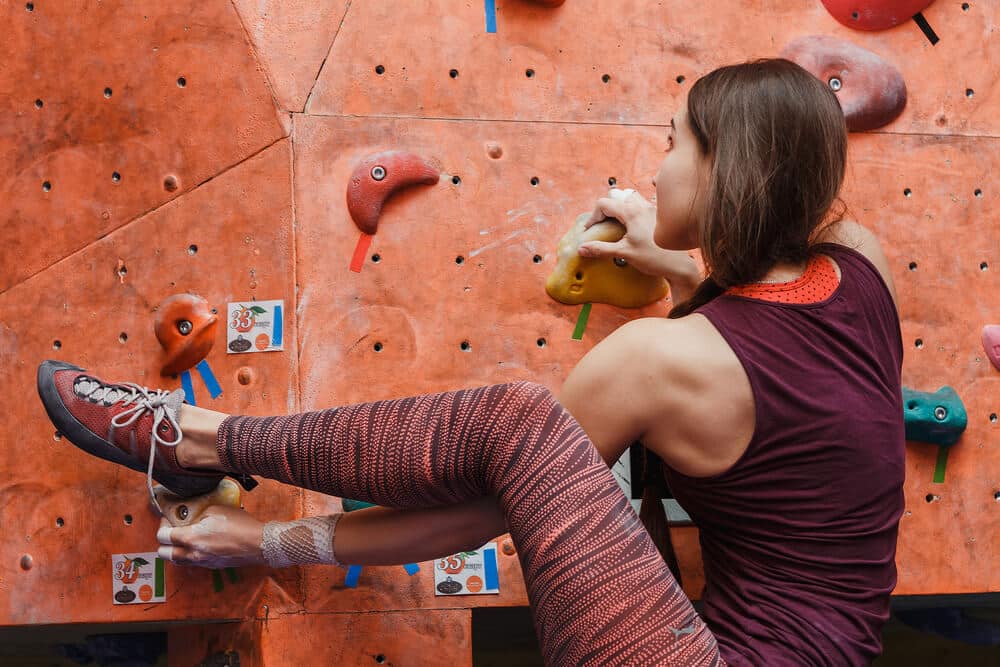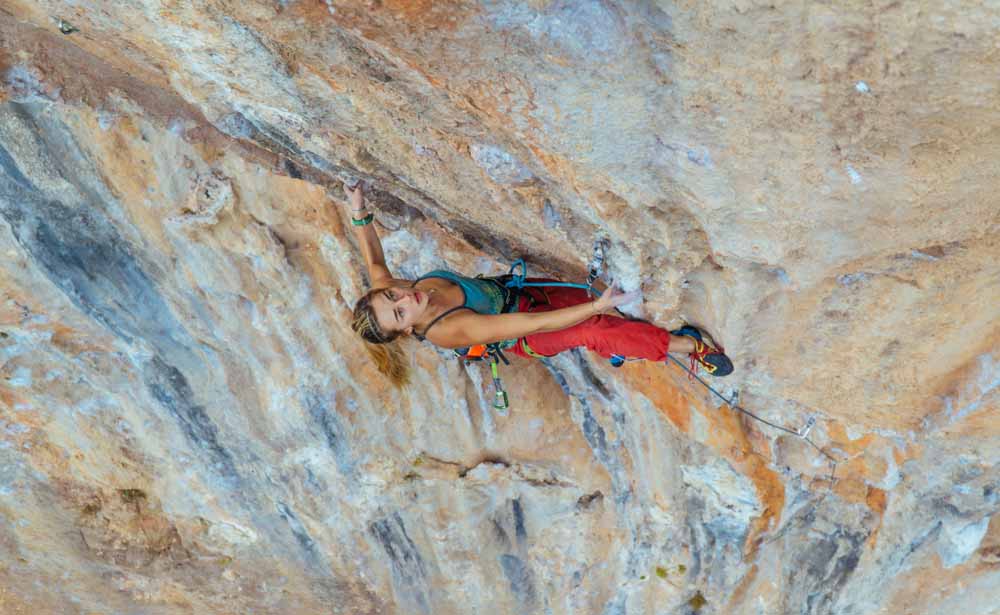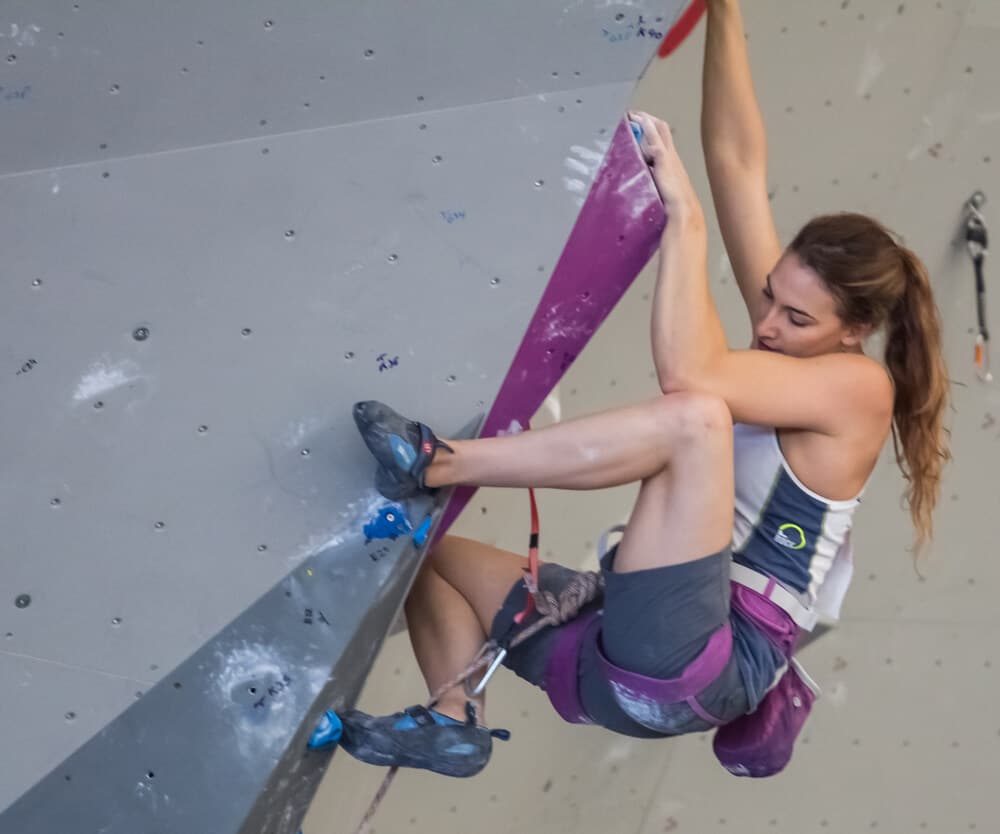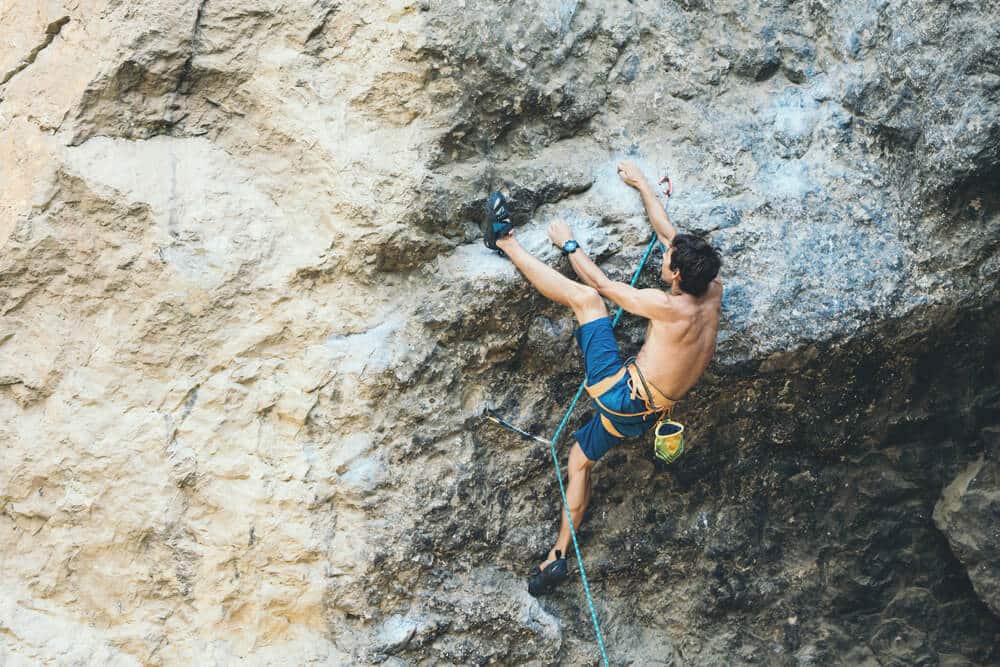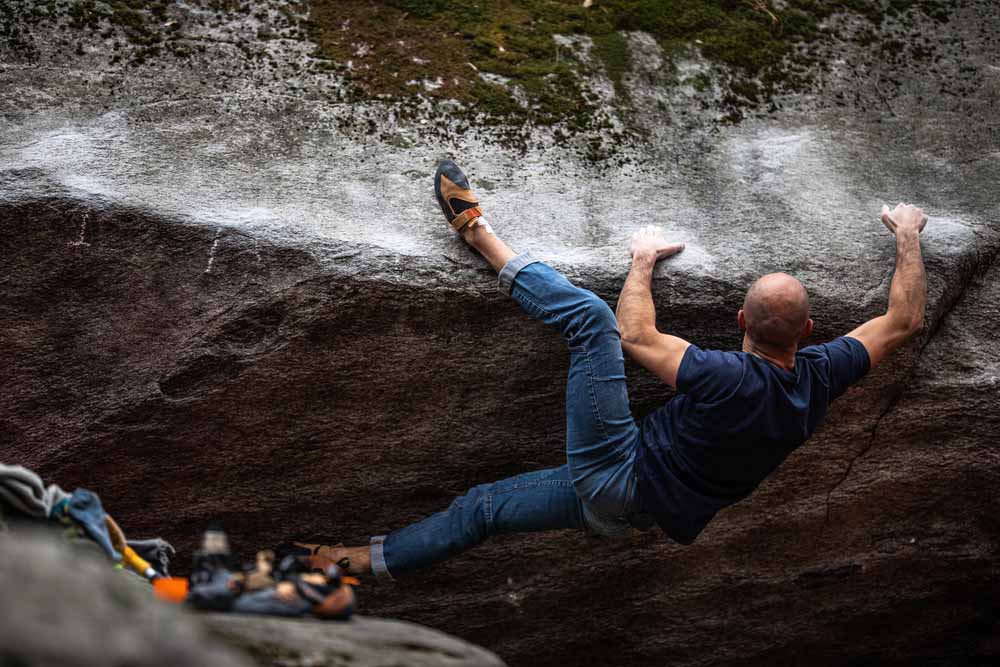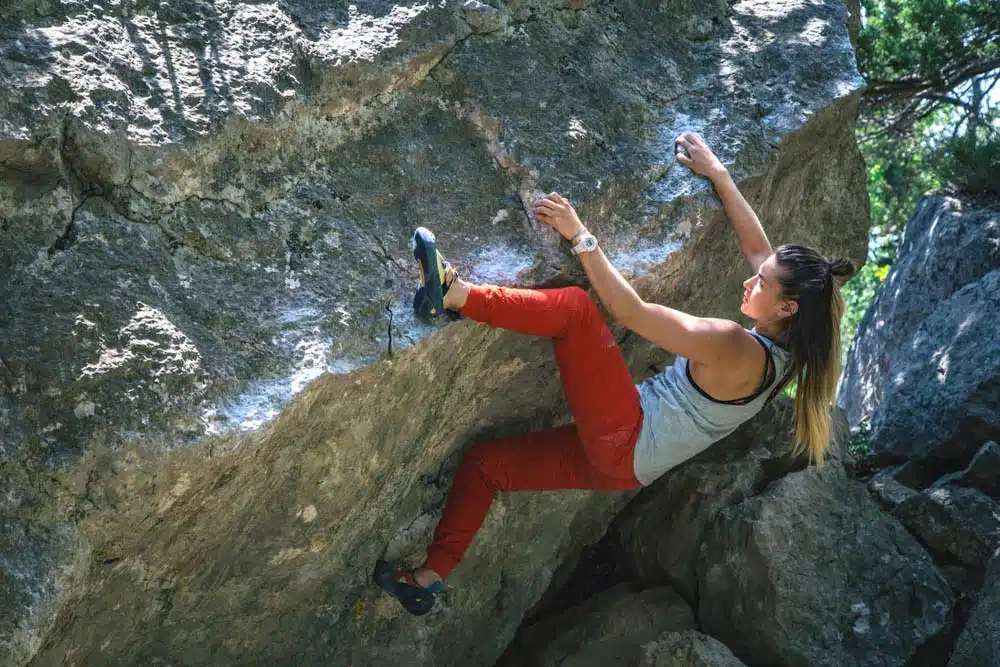If you’ve been rock climbing for a while, you’re probably familiar with the heel hook. Although relatively simple on the surface, this technique has lots of nuance and takes time to master.
Whatever level of climber you are, improving your heel hooks can help boost your climbing to a new level.
Note: Interested in other climbing techniques? Check out out our post on knee bars to take things a step further.
What is a heel hook?
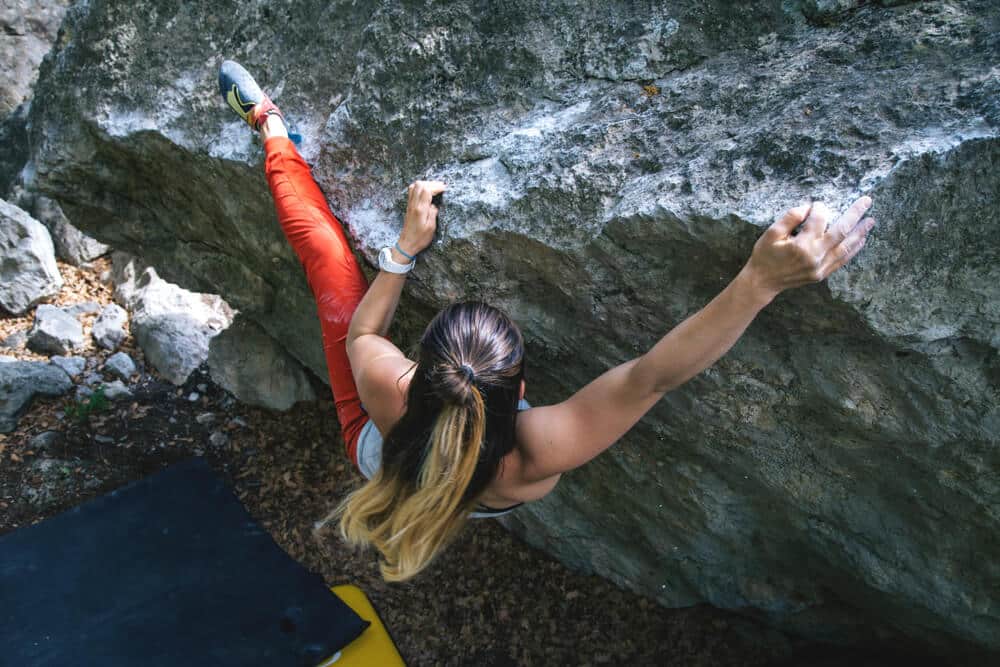
Heel hooking is basically what it sounds like: using your heel to hook holds. This can help you pull yourself up the wall, move your body weight sideways, or maintain your position instead of falling. Performing a high heel hook can also be a good solution when there don’t appear to be any viable footholds at feet level.
Where to use heel hooks
One of the major challenges in mastering the heel hook is understanding where and when it can be used. Many newer climbers miss heel hooking opportunities, as they can be challenging to spot at first. In general, large holds such as slopers, volumes, ledges, rails, and jugs can be good locations for heel hooks.
Let’s take a look at some specific climbing scenarios where heel hooks are useful.
Rock overs
If you need to rock your weight over your foot, a heel hook can help you do this. If you have your foot placed normally on a hold that you need to rock over onto, it can be difficult to get enough momentum and power to do so since you’re moving your body primarily by pulling with your upper body. Using a heel hook instead means that you can use the large muscles in your legs to move your body weight, and it can also help you get your hips closer to the wall.
Overhung terrain
Heel hooks are a crucial technique for overhung terrain because they can help take weight off of your upper body. Holds tend to be larger on steep climbs, so it’s easier to use a heel hook, and it will give you more purchase on the holds than simply placing your foot on them.
Think of your leg as a third arm that you can use to keep yourself on the wall or make progress up the route. With one heel hook, you can move your other foot without cutting feet completely, which saves energy.
Arêtes
If you ever climb routes on an arête, there’s a good chance you’ll have to heel hook. This is sometimes referred to as a compression heel hook, and it can help you maintain body tension in insecure positions.
The basic principle here is that you hook your heel around the side of the arête and use your leg muscles to stabilize your body so you can shift your weight or make the next move. Find a good foothold for one foot, and then place your other foot around the corner of the rock. Try to look for indentations and features on the arête that you can hook your heel on.
Mantles
Mantles are another spot where you may need to use this rock climbing technique. To execute this crucial heel hook, you’ll usually put your foot all the way up on the target hold or ledge that you’re mantling onto, and then use your leg to help pull your body onto the hold. It’s important to have good hip flexibility for this technique, as you’ll typically be placing your foot at waist level or above.
For resting
When you’re sport climbing, the heel hook position can be used to rest. If you can find a good heel hook, it will help take some of the pressure off of your arms and give you a chance to shake out and recover.
Heel hook technique
There’s a lot of technique to the heel hook. Outlined below are some key points. If you want a visual aid, there’s lots of videos that have helpful advice, such as this one from Lattice Training. Keep these tips in mind during your next climbing session!
Toe position
For an effective heel hook, you’ll usually want to point your toes down. This helps your heel dig into the hold. An important consideration here is that when you do this, the part of your heel that is in contact with the hold shifts a bit lower as your foot rolls. Play close attention to this shift when choosing the starting position for your heel placement: you probably want to place it a little higher than where you want it to end up.
Foot position
Being intentional about the way your foot is positioned can make your heel hooks more effective. In general, try to have your toe pointing slightly out from the wall– an angle of somewhere between 10 and 45 degrees. With this toe position, and your ankle turned into the wall, you’ll get the most power from the heel hook.
On some holds, you may be able to combine a heel hook with a heel toe cam. A heel toe cam refers to a situation where you wedge your foot between holds so that both your heel and toe are in contact with the rock. This way, you gain extra purchase on the wall and your foot has more pulling power. If there’s a place to heel hook where your toes can also be in contact with the wall, adding a heel toe cam to your heel hook may be beneficial.
Body position
The correct body position depends on the goal of your heel hook. If you are rocking over onto a hold or mantling, you’ll want to pull your hips towards your foot. This can also be a good strategy for resting, as it can help you take pressure off of your arms.
If you are utilizing a heel hook to maintain tension, such as heel hooking around an arête, shifting your body weight towards your foot can actually be counterproductive, as that will reduce the tension and likely cause you to fall. Instead, try lengthening your leg and shifting your center of gravity away from your leg.
Heel hooks versus toe hooks
A toe hook is similar to a heel hook in that it is a method of hooking your feet around holds in order to reduce strain on your arms and maintain tension. Some holds can be toe hooked or heel hooked, while with other holds one technique will be your only option. It’s more common to use a heel hook climbing, but toe hooks are still important to have in your climbing arsenal.
To execute a toe hook, the top of your toes must come in contact with the underside (or sometimes side) of a hold. Think large undercut flakes or downward-facing rails. You can also toe hook around the side of arêtes or on large side pull holds. Once your foot is in contact with the hold, pull with your lower leg, like your shin muscles, to get the toe hook to stick.
If you’re choosing between a heel hook and a toe hook, there are a couple things to consider. The heel hook technique utilizes more powerful leg muscles, so it’s a stronger and more stable technique overall. However, a toe hook extends your reach. If you need to make a move left and you’re hooking a hold to the right, a heel hook will drastically limit your motion left, whereas a toe hook gives you a little more reach in that direction.
Common mistakes
Heel hooks are one of the most important climbing techniques, but there are some mistakes that many beginner climbers make when executing a heel hook.
Missing the opportunity
The most common heel hooking mistake is not using it! It can he hard to identify when heel hook moves are necessary or helpful. Remember to look for all of the situations discussed above. If you’re climbing outdoors, look for ledges and rails. If you’re indoor climbing, look for large volumes and slopers.
If a move feels impossible, consider if there are any holds you could heel hook. Or, if you feel like there are limited footholds on a climb or the climb has very poor footholds, try using a heel hook in combination with a hand-food match: heel hook the same hold your hand is on.
Not powering through the heel
Another common mistake with heel hooking is not using the tension and power the position gives you as much as you could. Sometimes you’ll see beginner climbers heel hook a hold, but instead of pulling with their leg, they continue to pull harder with their arms. This defeats the purpose of using the technique in the first place! To avoid this mistake, whenever you utilize a heel hook, be intentional about maximizing the power it gives you.
Wearing the wrong climbing shoe
It’s important to have good climbing shoes for heel hooking. Good heel hooking shoes have adequate rubber on the heel so you can drive powerfully through your foot. Another consideration for your shoes is how well the heel fits your feet. To heel hook well, you want a heel cup that’s tight to your skin.
The La Sportiva Solution Comp is a good shoe for performing heel hooks, as is the Scarpa Drago. Both of these shoes are downturned with lots of rubber coverage, making them great options for bouldering or steep sport climbing. An example of a climbing shoes not to wear while performing a heel hook are the Scarpa Veloces— this shoe has soft and thin rubber over the heel.
Avoiding injury
The heel hook is an essential climbing technique, but it also presents a risk for injury. When you execute a heel hook, you apply pressure to the hamstring and knee. Since these body parts aren’t commonly used during climbing, they’re at a higher at risk for getting hurt. Common heel hooking injuries include hamstring strains or tears, or injury to parts of the knee such as the posterior cruciate ligament (PCL) or the lateral collateral ligament (LCL). Fortunately, there are steps you can take to avoid these issues.
Strength training
Many climbers neglect their lower body in their training and climbing, but this can be a recipe for disaster. Strengthening your legs and glutes ensures that your lower body is strong enough to meet the demands of heel hooks.
A good exercise to start with is hamstring curls. Lay on the ground and place your feet on an exercise ball, raising your hips up to create a bridge position. From there, lengthen and contract your legs, rolling the ball with you as you go. Start with three sets of ten. If that feels to easy, perform the exercise with one leg at a time. You can also place a weight on your pelvis to make the exercise more challenging.
Two more exercises that increase your hamstring and glute strength are bridges and squats. To do a bridge, lie on your back with your knees bent. Place a dumbbell on your pelvis, and then raise your hips up until they’re in line with your shoulders and knees. Perform three sets of ten. You can do three sets of ten squats too– just hold a dumbbell in your hands to make the exercise more challenging.
Warming up
In order to heel hook safely, you need to be adequately flexible and warmed up. If your muscles and stiff and tight, they’re more likely to be torn or strained. To prevent this, try adding some lower body mobility to your warm-up routine, especially if you know you are going to be trying a climb with an aggressive heel hook. Add hip and leg stretches to your cool-down routine.
Final Thoughts
This article covered the climbing technique of heel hooking, including nuances of executing a heel hook, common spots where this technique is used, and mistakes that are easy to make. Most climbers heel hook at least occasionally, so it’s important for anyone who enjoys climbing to understand how to heel hook well, and how to stay healthy while doing it.
Heel hooks are common in modern bouldering, and many people find that they’re essential for indoor climbing. However, heel hooks are also useful in outdoor sport climbing and can even come in handy on trad routes from time to time.
Sources



